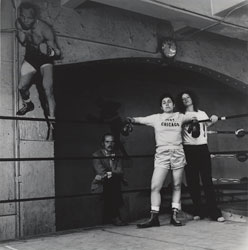March 3rd - April 7th, 2012
Reception: March 3rd, 2012 4-6PM
A native of Oklahoma, Jerry McMillan moved west in 1958 with childhood friends Ed Ruscha and Joe Goode. The three of them lived together while attending Chouinard Art Institute in Southern California. McMillan quickly became a key figure in the development of photo-sculpture and was given a solo exhibition by Walter Hopps at the Pasadena Art Museum in 1966. His work was later included in Peter Bunnell’s seminal exhibition, Photography Into Sculpture which opened at the MOMA in New York in 1970. Currently, he is the subject of a retrospective exhibition curated by Steven Peckman at Cal State University Northridge through March 31st. That exhibition, as well as the McMillan and Hopper exhibits opening at Craig Krull Gallery, are all part of the Getty’s initiative, Pacific Standard Time: Art in Los Angeles 1945-1980.
The Artist’s Image at Craig Krull Gallery will focus on one aspect of McMillan’s artistic practice, his photographic portraiture of artists. This exhibition demonstrates his inventive techniques and collaborative efforts at creating a persona rather than a mere likeness. Through symbolic and whimsically staged role-playing, McMillan produced implied narratives that were often intended for exhibition announcements and magazine advertisements. For example, when he was told that Judy Gerowitz was changing her name to Chicago and needed an image to announce her new name and upcoming exhibition, he put her in a boxing ring. The tough, confrontational photo of Chicago, wearing boxing gloves with her name emblazoned across her chest, suggested a challenge to the male-dominated art scene in L.A. In fact, during the 60s, artists in L.A would one-up each other with ego-driven exhibition announcements picturing themselves in underwear, surfing, or performing other antics. In this vein, McMillan created a folding exhibition poster/invite for his friend Joe Goode that pictured the artist, but did not include Goode’s name, implying, that his name was not even necessary. The exhibition at Craig Krull Gallery will include McMillan’s vintage photos, contact sheets and examples of his work in exhibition announcements, catalogue design, magazine ads, and even personalized artist stationery. Jerry McMillan’s contributions in these areas were vital to the developing LA art scene, not simply in the presentation of L.A. artists, but in his shaping of how they were perceived.
Concurrently, the gallery will present an exhibition of photographs from the 1960s by Dennis Hopper. The Fort Worth 400 consists of the original and intact collection of over four hundred vintage 6x9” photographs that were included in Hopper’s 1970 exhibition organized by Henry T. Hopkins for the Fort Worth Art Center Museum. (Coincidentally, Hopper was exhibited concurrently with Jerry McMillan at Forth Worth as well). The exhibit includes Hopper’s iconic images of artists, film stars, musicians, poets, bikers, beatniks, hippies, and civil rights marchers. In the essay for Hopper’s book, Out of the Sixties, Michael McClure wrote, “There are no portraits here. These are not portraits….It’s all in the air like a ball tossed from the hand.” Hopper’s street scenes and pictures of bold signage and graphics, such as Double Standard, parallel the interests of Pop artists and Ed Ruscha. His images of torn, decayed and painted-over posters plastered on walls suggest an aesthetic akin to both the California Assemblage of his friends and the visceral paintings of the Abstract Expressionists.

